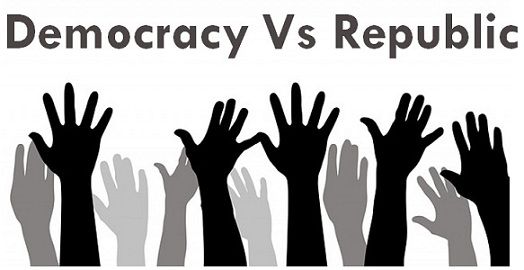 There are many forms of political systems which are prevalent in different countries of the world for a long time like monarchy, oligarchy, anarchy, democracy and republic. Of these forms of government, democracy and a republic are quite often juxtaposed, but there is a fine line amidst the two. Democracy refers to the system of masses, i.e. a political system dominated by citizens of the country. Under this system, the general public possess a certain degree of power and authority and takes part in the decision making process of the state.
There are many forms of political systems which are prevalent in different countries of the world for a long time like monarchy, oligarchy, anarchy, democracy and republic. Of these forms of government, democracy and a republic are quite often juxtaposed, but there is a fine line amidst the two. Democracy refers to the system of masses, i.e. a political system dominated by citizens of the country. Under this system, the general public possess a certain degree of power and authority and takes part in the decision making process of the state.
Republic refers to the state wherein the ultimate power lies in the hands of the people and their elected represetatives. Here, the representatives are chosen by the people to vote on behalf of them.
This article excerpt sheds light on the differences between democracy and republic, take a read.
Content: Democracy Vs Republic
Comparison Chart
| Basis for Comparison | Democracy | Republic |
|---|---|---|
| Meaning | Democracy typically means, people's system. | The republic is the form of government in which the people choose representatives to represent them. |
| Rule | By majority | By law |
| Origin | Greek language | Latin language |
| Minority rights | Overridden by majority | Inalienable |
| Sovereignty rests with | The population (all the people taken together) | The people (individuals) |
| Revenue through | Illegitimate taxes, fees, fines and licenses | Legitimate taxes and fees |
| Mobocracy | Prevails | Does not prevails |
Definition of Democracy
The word democracy is a combination of two Greek words ‘demos’ means people and ‘kratein’ means, to rule. In short, it means ‘the rule of people’. It is the government which is ruled by the citizens of the country, also known as the system of masses. Majority rule is the essence of this system.
In the democracy, there is active participation of the general public in the political and decision-making process of the state. Free and fair elections are held to choose and replace the government. People get equal rights in a democracy, and the law applies to all the citizens of the country in an equal manner.
Definition of Republic
The term republic is a Latin origin, made of two words ‘res’ means a thing and ‘publica’ means public, that refers to ‘ the public thing i.e. law’. It is considered as the standard form of government, which is ruled by the citizen’s representative chosen by them through voting. The government leaders can exercise their powers as per the rule of law.
The Republic is the representative democracy where there is an elected chief of the state, who serves the state for a certain period, known as the President. In this political system, the government cannot take away the inalienable rights of the individual. In other words, the right of an individual cannot be overridden by the masses.
Key Differences Between Democracy and Republic
The major differences between democracy and republic are provided in the points given below:
- Democracy is defined as a political system which is made by/of/for the people. The republic is the representative democracy with the chief of the state known as president.
- In a democracy, the rule of majority people prevails whereas in the case of the republic the rule of law prevails.
- The term democracy is derived from two Greek words ‘demos’ and ‘creating’ that means ‘the rule of the people’. On the other hand, the term republic comes from a two Latin words, i.e. ‘res’ and ‘publica’ that refers to ‘a public thing, which is the law’.
- In a democracy, minority rights are overridden by the majority. Conversely, Republic system protects the rights of minority groups or an individual.
- In a democracy, the power rests with the population, however in the case of the Republic the power is in the hand of law which are created to safeguard the interest of the people.
- The Democratic system gets finance through illegitimate taxes, fees, fines and licenses. Unlike Republic, where legitimate taxes and fees.
- Democracy amounts to mobocracy which is not in the case or the republic.
Conclusion
As we have discussed above, both the systems have their positive and negative aspects. Democracy gives equal rights to all the citizens of the country. As opposed to, a republic where all the citizens get the right to vote to select their representative.






Marcela says
Thank you, Marcela
Joseph E Macaluso says
It would seem the liberal agenda is to have American people believe the United States is a Democracy as outlined above. When in fact our country from the beginning has always been a republic.
Tristen Hoohuli says
Very much true
Pat O'Brien says
Is it true to say however that the Republic is in fact a mixture of both? The leaders are (usually) selected by majority vote, and they then govern in accordance with an agenda that is influenced by their voters, relying on their majority in parliament to do so? Majority rule by way of representative voting is a daily reality in any republic.
Rev. Dan Batson says
exactly ….